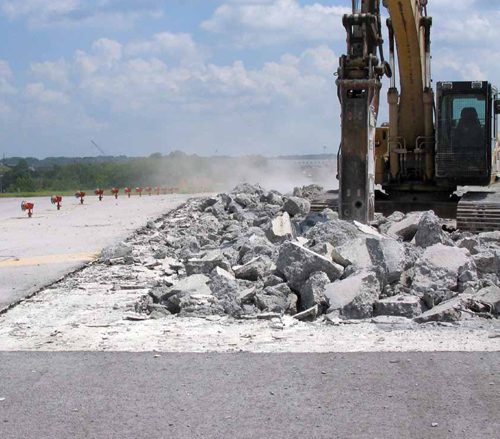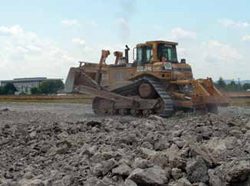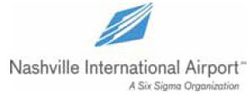
|
Removal of runway markings was an important step in recent reconstruction and rehab work at Nashville Int’l. |
“The pavement had come to the end of its useful life, which mandated a full-depth reconstruction,” relates BNA’s construction director, Christine Vitt.
In anticipation of the major reconstruction project, the airport reconstructed the intersection of runways 2L-20R and 13-31 in 2007 to avoid closing two runways during the year long reconstruction of 2L-20R. The runway project was divided into two distinct portions, with crosswind runway 13-31 serving as the dividing line.
 “Geotechnical investigations revealed two very different substrates north and south of the intersection, which would likely require a different pavement design for each section,” Vitt explains.
“Geotechnical investigations revealed two very different substrates north and south of the intersection, which would likely require a different pavement design for each section,” Vitt explains.
The airport was also unsure whether available funding would cover the cost of reconstructing the entire runway. As a result, the airport hired two engineering and design firms: Garver, LLC for the south section and Allen & Hoshall for the north.
Two Firms, One Set of Drawings
Two engineering firms designing a single runway reconstruction project is unusual, to say the least. But both firms understood immediately that open and frequent communication between the two companies would be critical to the project’s success.

“I could imagine the project going sideways with two consultants who regularly compete for work at the same airport working on the same project,” says Ryan Sisemore, project manager for Garver. “Harry and I worked very hard to build a relationship – and a friendship – to ensure we delivered a great project to the airport.”
 Harry Pratt, vice president of Allen & Hoshall, concurs: “We got together very early in the project and established how we would work together. We decided that we would share design and engineering details, most of which were compatible for both ends of the project.”
Harry Pratt, vice president of Allen & Hoshall, concurs: “We got together very early in the project and established how we would work together. We decided that we would share design and engineering details, most of which were compatible for both ends of the project.”
The two firms consolidated their designs into a single set of drawings/specifications, and the seals of both companies were affixed to the documents. “We wanted to make sure the general contractor would remain somewhat oblivious as to who the designer was,” recalls Pratt. “We didn’t want the contractor to worry about north end/south (division). We knew he could build it better and cheaper if he didn’t have to fight his way through two sets of everything.”
 The project’s size and scope prompted the general contractor to set up an elaborate staging area, complete with an onsite crushing/screening plant and three concrete batch plants.
The project’s size and scope prompted the general contractor to set up an elaborate staging area, complete with an onsite crushing/screening plant and three concrete batch plants.
“We brought in two batch plants for the north end, where we started,” recalls Jim Thomas, vice president of operations for The Harper Company. “When the north end was nearly finished, we moved one of the batch plants over to the south end, then brought in another one for the south end. We had to leave one on the north end because we had a little more work to complete. Running two batch plants at a time, we had a couple of 6,000-cubic-yard days.”
|
factsfigures Runway: 2L-20R Project: Runway Reconstruction Location: Nashville International Airport Cost: $28.5 million Funding: FAA (57%), state funds (12.5%), passenger facility charges (30.5%) Key Contractors Engineering & Design: Garver, LLC; Allen & Hoshall General Contractor: The Harper Co. Asphalt: Lojac Enterprises Grading: Division 2 Constructors Electrical/Lighting: Hypower Geotechnical: K.S. Ware & Assoc. Pavement Markings: Peek Pavement Markings Lighting & Signage: ADB Airfield Solutions Project: Runway Rehabilitation Location: Nashville International Airport Runway: 2C-20C Cost: $600,000 Funding: State (90%), Metropolitan Nashville Airport Authority (10%) Key Contractors General Contractor: Lojac Enterprises Electrical/lighting: Stansell Electric Seal Coat & Pavement Marking: Kerr Brothers & Assoc. Security Fencing: Prime Security Rubber & Marking Removal/Runway Marking: Peek Pavement Markings, Waterblasting Technologies Concrete Patch Supplier: D.S. Brown |
Approximately 66,000 cubic yards of new concrete, 90,000 tons of asphalt, 90,000 tons of recycled concrete, 27,000 tons of recycled asphalt and 9 miles of cable were used to construct the new runway. Thirty-five-foot asphalt shoulders were added to improve the safety and integrity of the runway, and a new lighting and signage system from ADB Airfield Solutions was installed.
According to airport officials, the $28.5 million project sustained about 300 jobs over the course of the year.
Saving Money the Green Way
|
|
 When the runway closed, construction crews demolished the pavement with a guillotine breaker/rubblizer. The concrete was then hauled to the onsite crushing and screening plant, where it was pugmilled to the appropriate size and moisture conditions before returning to the project.
When the runway closed, construction crews demolished the pavement with a guillotine breaker/rubblizer. The concrete was then hauled to the onsite crushing and screening plant, where it was pugmilled to the appropriate size and moisture conditions before returning to the project.
Nearly 90,000 tons of aggregate were produced from the 7,700-foot runway. In addition, 27,000 tons of asphalt were recycled. Steel dowel and reinforcing bars were separated during the recycling process and transported to a steel recycling company in Nashville.
“Going green” on the project saved the airport roughly $2 million, dropping the cost of aggregate placement from $26.91 per ton for virgin material to $4.87 per ton for the recycled concrete aggregate. It also earned the project distinction as one of three finalists in Bentley Systems’ 2010 “Be Inspired Award” for innovative installations.
“Though we did not win first place,” Sisemore reflects, “being a finalist and presenting the project to an international audience in Amsterdam was, in itself, a very nice recognition.”
In retrospect, Thomas identifies teamwork between the owners and engineers as the key to its success.
“There were many opportunities for failure,” he notes. “But because of the cooperation among all parties, there was no butting heads, no arguments. The project went very smoothly, and everyone gets credit for that. I’d take one of these jobs every year if I could get it.”
No Need to Wait
When 2L-20R opened for business in August 2010, BNA wasted no time before starting its next runway project. Runway 2C-20C shutdown in early September for rehab and reopened on December 29.
 “We decided to take possession of the entire runway to do all the required maintenance rather than shut it down numerous times to work on different areas of the runway,” relates Vitt. “It made the work much more efficient.”
“We decided to take possession of the entire runway to do all the required maintenance rather than shut it down numerous times to work on different areas of the runway,” relates Vitt. “It made the work much more efficient.”
While the bulk of the work entailed cleaning and resealing the pavement joints with silicone, general contractor Lojac Enterprises also performed some full-depth and partial-depth patching with Delcrete(tm), a concrete patching material manufactured by D.S. Brown.
Lojac contracted Peek Pavement Markings to perform rubber removal and re-stripe the runway.
“The rehab was actually finished in October,” Vitt explains, “but we kept the runway closed through December to complete work on adjacent taxiways. Closing the runway one time meant fewer interruptions for our airline tenants.”




